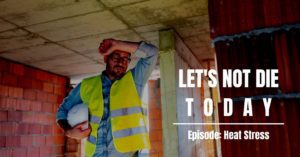Toolbox Topic: Heat Stress
Illnesses associated with heat stress exposure are totally preventable. Even so, every year, thousands of workers become ill and, in some cases, even die from it. In this episode, we’ll discuss what heat stress is, how it affects your health, and how to prevent it.
Definitions of Heat stress
According to the CDC, heat stress: The net heat load to which a worker is exposed from the combined contributions of metabolic heat, environmental factors, and clothing worn, which increases heat storage in the body.
 Heat stress is when the body can’t cool down. This condition can result in heat rashes, heat cramps, heat exhaustion, and heatstroke. The effects of heat can increase the risk of worker injuries as it can result in sweaty palms, fogged-up safety glasses, and dizziness.
Heat stress is when the body can’t cool down. This condition can result in heat rashes, heat cramps, heat exhaustion, and heatstroke. The effects of heat can increase the risk of worker injuries as it can result in sweaty palms, fogged-up safety glasses, and dizziness.
History of Heat Stress
Early History
Heatstroke prevention was first described in 332 BC. Alexander the Great advised his army not to march on sunny days without enough water.
In 400 BC, Hippocrates described how the violent heat from the sun might cause convulsion and fever.
In 1020 the book “The Canon of Medicine” described preventive measures and precautions for traveling on sunny days.
The 1800’s up to Modern Times
The first death of a U.S. Navy sailor caused by heatstroke was recorded in 1865.
In 1885 during the war between the states, 313 soldiers died of heatstroke.
In 1935, D.H.K. Lee gave a lecture to the Royal Society of Medicine in London, differentiating heat stroke, heat exhaustion, and heat cramps as distinct illnesses.
During World War II, approximately 250 fatal cases of heatstroke occurred in the U.S. military, mostly in military basic training camps in the southern United States.
A Major News Story on Heat Stress
On February 17, 2003, a major news story broke about Steven Bechler, a Baltimore Orioles pitcher. The Orioles selected Steven Bechler in the third round of the 1998 MLB draft. In 2001, he was named a Carolina League All-Star but never appeared in the All-Star Game, as he was promoted to AAA ball. After struggling through several outings, he was demoted to the A.A. Eastern League. But in 2002 his performance improved, and at the end of the minor league season, the Orioles called him up to the major leagues. He appeared in three games for the Orioles.
During the Orioles’ 2003 season’s spring training, Bechler collapsed from heatstroke while participating in conditioning drills. He was rushed to a nearby hospital and diagnosed with abnormal liver function and mild hypertension. This condition, combined with the fact that he was not used to Florida’s warm weather and was using the supplement ephedra (a weight loss and energy supplement), proved to be a deadly combination. He died the next day.
Although Bechler did suffer from asthma as a child and endured heat strokes while in high school, a medical examiner found the use of ephedra contributed to his death. Following this report, the Food and Drug Administration opened an investigation, which resulted in the banning of ephedra products in the United States.
High temperatures are dangerous. They can be even more dangerous when combined with energy pills or drinks that contain high amounts of caffeine, which can lead to injuries, illnesses, and even death.
Statistics on Heat stress
According to OSHA, millions of workers are exposed to heat in their workplaces. Between 50% and 70% of outdoor fatalities occur within the first few days of working in warm environments. Occupational risk factors for heat illness include:
- Heavy physical activity.
- Warm or hot environmental conditions.
- Wearing clothing that holds in body heat.
- Lack of acclimatization.
Exposure to environmental heat led to 37 work-related fatalities and 2,830 lost time incidents in 2015.
According to the BLS Thirty-three of the 37 fatal work injuries caused by exposure to environmental heat occurred in the summer months of June through September.
Heat stress can happen at home too! According to the CDC, more than 65,000 people visit the emergency room for heat-related stress every year, and about 700 die from heat-related causes.
Safety Tips on Heat Stress
Safety Tip #1 Clothing
During the summer months, wear lightweight, loose-fitting, light-colored clothing. There are newer lightweight, dry-fit materials in the market today that can help you keep cool during those warm summer months.
Safety Tip #2 Hydration
Stay properly hydrated. Make sure you drink lots of fluids—at least one pint per hour. Drink often and BEFORE you are thirsty. Drink water every 15 minutes. Avoid alcohol and caffeine. Oh, and fellas, check your urine. The darker it is, the more likely you are not hydrated.
Safety Tip #3 Take Breaks
Take frequent breaks in the shade or other cool areas to allow your body to cool down. Take the opportunity to drink more fluids!
Safety Tip #4 Know the Signs!
Symptoms of heat exhaustion:
- Headache, dizziness, or fainting
- Weakness and wet skin
- Irritability or confusion
- Thirst, nausea, or vomiting
Symptoms of heatstroke:
- confusion, unable to think clearly, passing out, or even seizures (fits)
- May stop sweating
Safety Tip #5 What to Do in an Emergency
If a worker appears to be suffering from heat stress, call a supervisor. If you cannot find a supervisor, call 911. Move to a shaded area or anywhere the worker can cool down. Do not leave the worker alone. Someone must stay with them until help arrives. Remove clothing and fan or mist the work with water. Provide cool drinking water. If at any time the worker appears confused, disoriented or loses consciousness, call 911 as this could be signs of a heat stroke.